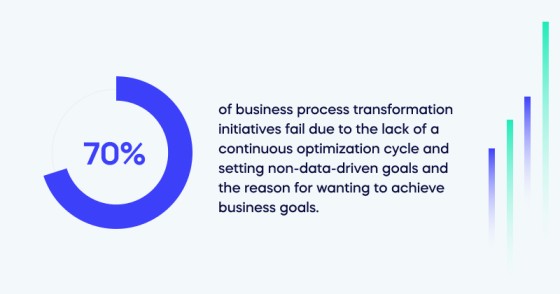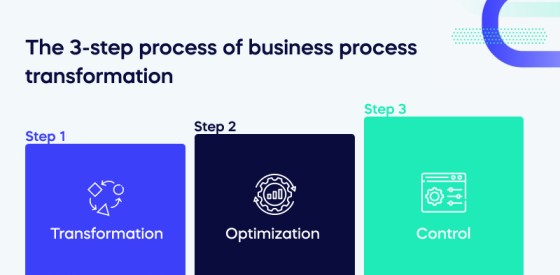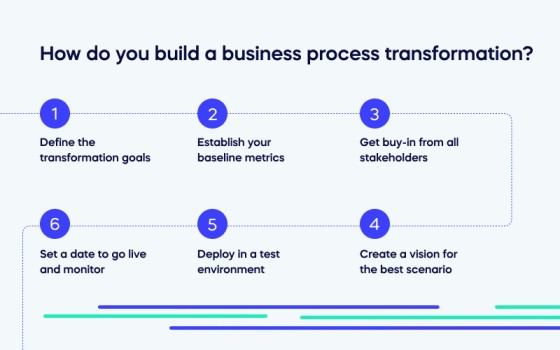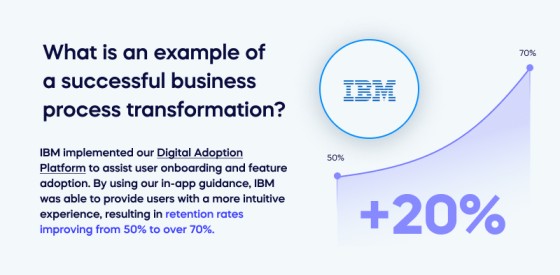How do you ensure every business process runs smooth as butter?
There are no runner-up prizes in business, so there should be only one answer: business process transformation.
And with the digital transformation market due to grow to USD 521.5 billion by 2026, now is the best time to invest.
Business process transformation is a holistic approach that seeks to identify, analyze, and improve existing organizational processes.
Doing so can range from redesigning the entire process to implementing new technology and tools. With a successful transformation, organizations can save time, money, and resources while improving customer experience and increasing operational effectiveness.
However, achieving successful business transformation is no walk in the park; it is essential to consider the challenges and plan for them in advance.
To help you understand the importance of business process transformation, we will explore the following topics:
- What is business process transformation?
- What are the drivers of business process transformation?
- Why does business process transformation?
- How to ensure your business process transformation succeeds
- What is an example of a successful business process transformation?
What is business process transformation?
Transforming business operations is a comprehensive and ongoing effort to adjust to new situations and meet business objectives. It involves significant changes to existing processes and must align with the company’s strategy.
What are the drivers of business process transformation?
In 2022, the worldwide expenditure on digital maturity initiatives and transformation programs will reach two trillion dollars.
However, the top minority of companies earn the majority of digital revenues. Therefore, it won’t be beneficial to be in the average-performing companies in the future.
70% of business process transformation initiatives fail due to the lack of a continuous optimization cycle and setting non-data-driven goals and the reason for wanting to achieve business goals.

For business leaders to succeed for their companies, they must have a clear mission and implement a new business transformation process model to quickly achieve operational excellence with an updated business approach.
However, companies realize that transforming involves more than creating a new business strategy.
A clear vision for running your business and keeping up with competitors’ innovations is also essential. A vision allows you to meet users’ rising expectations, adapt to changing regulations, and maintain high-quality and transparent operations.
The 3-step process of business process transformation

Business process transformation steps divide into transforming, optimizing, and controlling processes.
Implementing this business process transformation methodology involves defining a strategy, rethinking working methods, supporting execution, and monitoring results.
1. Transformation
Adapting to industry disruption is a challenge for companies. The digital landscape constantly changes, and past success does not guarantee future results.
Companies must continuously align their business model to new challenges to survive. However, how can they connect their strategic business model to the operating model for successful digital transformation efforts?
The answer will vary depending on your organization, but you must discuss it to ensure success for all new processes leading to ROI on business outcomes.
2. Optimization
Businesses face challenges in improving their processes and exploring innovative approaches to their operational efficiency as part of their business process improvement.
However, they often struggle to achieve success with transformation and change initiatives because they underestimate the importance of managing human factors and business process management practices.
Project success or failure largely depends on effective change management and adoption, which account for a large proportion of the outcome.
Employees lack a clear understanding of the organization’s way of working and specific roles, as they lack the necessary guidance (such as work instructions, policies, and guidelines) tailored to their job functions, which hinders collaborative efforts across the enterprise.
3. Control
Most businesses face difficulties effectively measuring, monitoring, and managing their business processes, including meeting strategic and compliance requirements.
Decision-makers often lack an overview of how healthy processes are running and the status of compliance and risk mitigation measures. Consequently, they cannot respond promptly or capture and analyze data to help optimize operations.
Follow these steps to ensure success in implementing your business process transformation.
How do you build a business process transformation?

Follow these six steps to build a successful business process transformation that promotes growth via increased efficiency of their operational approach.
1. Define the transformation goals
First, identify the goals of your digital transformation.
Do so by asking the following questions:
- Are you primarily trying to upgrade systems?
- Do you need to incorporate new digital technology?
- Is it necessary to establish processes for a new organizational structure?
- What led to the need?
2. Establish your baseline metrics
Collect the data needed to show that your business process transformation will successfully establish baseline metrics to compare your new data to when you implement your transformation.
Think through cost, time, number of errors, and other metrics you can measure.
3. Get buy-in from all stakeholders
The success or failure of your transformation will impact stakeholders.
Get feedback from those involved in previous transformation on what worked well in prior processes and their expectations for the new one.
4. Create a vision for the best scenario
Create a workflow diagram that outlines the necessary human and system tasks. Use a diagramming tool and include all components required for an optimal workflow.
5. Deploy in a test environment
Next, you must deploy the transformation in a test environment using a BPM (business process management) tool to create a process in an experimental setting to observe how it operates between people and data.
6. Set a date to go live and monitor
Finally, it’s time to go live. Initially, involve small teams in the new process and carefully observe their progress while making any necessary changes for the process to succeed.
It is essential to follow these six steps to ensure the success of your business process transformation.
Why does business process transformation fail?
While business process transformation can create a strategic advantage and yield short-term gains, executing is often challenging.
Initiatives focused on transforming business processes and making changes often fail for many reasons, such as the following:
- Operational processes are not in sync with the strategic business model and lack comprehension of end-to-end processes.
- The absence of team member engagement to improve employee experience, an absence of cross-functional collaboration, insufficient management support, and a lack of accountability result in failed outcomes.
- The organization may face heavy fines and indirect losses if you do not comply with statutory regulations because processes’ performance and compliance status are not continuously measured.
Consider these reasons beforehand and meet these obstacles head-on to ensure they don’t cause challenges that may be too late to fix halfway through your transformation implementation and may lead to reduced employee retention, further delaying transformation progress.
How to ensure your business process transformation succeeds
To achieve success, protecting your transformation initiative throughout the entire process is essential, starting from strategy and extending to operations. Accomplish this by developing and aligning a business design strategy with the operating model.
Ensure everyone in your organization can access current work instructions, policies, and guidelines. Doing so will require managing your enterprise with complete visibility and alignment from end to end.
And finally, implement efficient methods for measuring, monitoring, and managing your transformation efforts. As part of this strategy, it’s important to integrate business transformation with resilient compliance management and efficient risk management.
What is an example of a successful business process transformation?

It’s challenging to imagine a business process transformation without seeing it in action, so let’s look at an example of a successful transformation.
IBM
IBM has evolved into a company that provides cloud services and cognitive solutions and is a long-time tech leader.
However, due to the complex nature of its B2B products, many of IBM’s innovative offerings were abandoned by users because of poor onboarding experiences and limited support. IBM realized they needed a new business process strategy for digital adoption to increase engagement and sales.
IBM implemented our Digital Adoption Platform to assist user onboarding and feature adoption. By using our in-app guidance, IBM was able to provide users with a more intuitive experience, resulting in retention rates improving from 50% to over 70%.
Additionally, IBM integrated WalkMe with essential applications to streamline data and analytics, which provided valuable insights into the user journey.
Overall, IBM has witnessed a 300% improvement in product usage, consumption, and retention since deploying the WalkMe platform to streamline its successful business transformation initiatives.
Invest in a DAP to ensure business process transformation success
Your users deserve top-quality experiences that revolve around their needs to help them make your organization stand out from competitors with high operational efficiency.
Gain meaningful insights into transparent operations and resolve issues to make well-informed, sustainable business decisions.
One of the easiest ways to implement a business process transformation is to use a DAP, which features in-app guidance and personalized training to save resources and reduce resistance to change, as the team can learn at their own pace.
With all the essential components in place and a robust commitment to your business process transformation goals across your organization, you can manage large-scale changes effectively for a successful transformation and sustained business growth.


